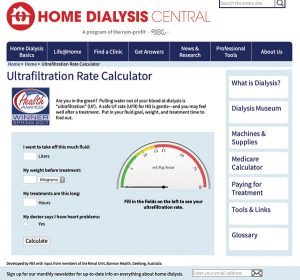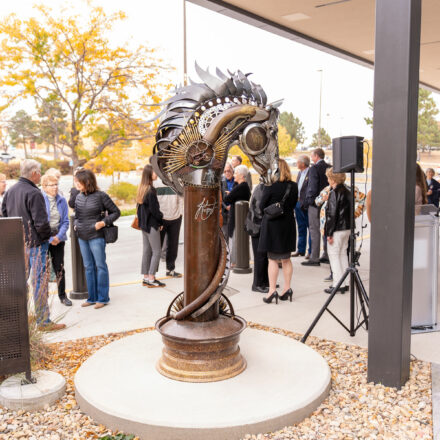Thank you for all that you do to help maximize quality of life for your patients. You are all amazing and we wish to thank each nurse, doctor, dietary and nutrition specialist and assistant. Even those who mop and clear the wastebaskets. Every piece of the puzzle is vital! Our mum is alive and we thank you for your part in that!

Patients with acute and chronic kidney failure may need dialysis. Dialysis is the artificial process of eliminating toxins and extra fluid. Caregivers and physicians at Monument Health Dialysis Centers in Rapid City and Spearfish understand that dialysis can present challenges for patients. Our priority is to provide a comfortable environment and high-quality care for our patients.
Caregivers on our dialysis team coordinate closely with nephrologists to ensure patients receive the care they need. Nephrologists are doctors who treat kidney disease and manage dialysis for patients. Our doctors bring years of experience caring for patients with kidney diseases and helping them preserve their kidney health. Please let us know if you have questions regarding our dialysis services.
If you are a dialysis patient planning to travel to the Black Hills, please call us. We will make every effort to accommodate your needs while you’re here.
Learn More About Dialysis
New to Dialysis?
1 out of 3 Americans are at risk for Kidney Disease; so, it is important to recognize that you are not alone. As a new dialysis patient, you have probably experienced a feeling of being overwhelmed. This page is designed to serve as your go-to guide for information and resources to help you transition into dialysis. Communication between you and your healthcare provider is important to your treatment. We encourage you to ask for further instructions on your treatment and, if explanations and the information that you have been provided seem unclear, ask questions. The National Kidney Foundation provides excellent tips on “How to communicate with your healthcare team.”
Maddy Warren
At the age of 13, Maddy Warren developed an autoimmune condition that had attacked her kidneys. She began with peritoneal dialysis and then moved on to hemodialysis before receiving a donor kidney from her father. However, her autoimmune condition was aggressive and, shortly thereafter, her new kidney failed as well. She now lives a full and active life without any kidneys. Maddy spoke of her experience twice on the TED stage.
Queen of Dialysis describes her dependence on a machine – TEDx Royal Tunbridge Wells (2015)
Queen of Dialysis: What Happened Next – TEDx Royal Tunbridge Wells (2017)
Organ Donation and Transplants
Maddy Warren’s condition made it impossible for her to receive a donor kidney; however, some dialysis patients are able to receive donor kidneys and have active lives. Monument Health Dialysis has an excellent team of social workers who are here to help you find the resources you need. If you are considering becoming a living donor or recipient, please contact your social worker. You can also visit the National Kidney Foundation for more information in preparation for you discussion with your social worker.
Allyssa Bates
Allyssa Bates became a living donor by giving up one of her kidneys. In her experience, she found it hard to find information on life after donation. To help future living donors such as herself, she discussed her experience on the TED stage at TEDx Beacon Street. There is a great need for kidneys and living donors play a large role in saving the lives of those suffering from kidney failure. If you, or someone you know, is interested in becoming a living donor, watch Allyssa Bates’ TED TALK and speak to one of our social workers for resources and help. You could save a life.
Confessions of a Kidney Donor: Allyssa Bates at TEDx Beacon Street
My Life, My Dialysis Choice
With kidney disease, every part of your life will be affected. My Life, My Dialysis Choice is a program of the non-profit organization Medical Education Institute (MEI). My Life, My Dialysis Choice is a tool to help you determine what dialysis treatment works best for you and your lifestyle. Follow the link and select the values you prefer for your lifestyle. Values choices for this program may include, but are not limited to, the following:
- “I need to be able to work or go to school.”
- “I need to feel in control of my time and my life.”
- “I want to stay out of the hospital.”
- “I don’t want to be a burden on my family.”
Once you have done so, the program will make suggestions based on these values. Print these suggestions, or write them down, and take them to your doctor to make a more informed and personalized dialysis treatment decision.
Kidney School
Kidney School offers free online learning for people with chronic kidney disease (stages 4-5).
- Easy to use and understand
- No need to register
- Reviewed by experts
- Three ways to learn: web, print and audio
Nutrition Information
When your kidneys are not working well or fail, waste products that would normally leave the body in your urine will remain in your blood. Dialysis can remove most of these waste products but not all. You can help control the amount of waste products that build up between your dialysis treatments by following a diet recommended by your renal dietitian. Diet recommendations will be based on your individual laboratory values, whether or not you have any residual kidney function, and if you have additional health conditions such as diabetes, high blood pressure or heart disease.
Learning to take charge of your food and fluids can help you feel better, improve your laboratory values and lead to a better quality of life.
Nutrients you may need to increase in your diet are protein and calories. Nutrients you may need to limit in your diet include: fluids, sodium, potassium and phosphorus.
Protein
Protein keeps your muscles strong and helps to prevent and fight infections. For best health, and to help replace what is lost during dialysis treatments, eat high protein every day. Good sources of protein include fresh and lean beef, chicken, turkey, eggs, fish, pork, seafood, beans, lentils, tofu and nut butters. Include a palm-sized portion of protein with meals.
Calories
Sometimes people with kidney disease lose weight unintentionally due to poor appetite, change in taste, dialysis treatments interfering with meals, too tired to eat, or problems with nausea and vomiting. If you are not eating enough calories your body can break down its own fat and muscle stores to provide needed energy. This can lead to feeling weaker and in general more tired. Achieving and or maintaining a healthy body weight is important to your overall health and quality of life. Ask your renal dietitian about ways to add more calories into your diet as well as different flavors to help foods taste better.
Fluid
One of the functions of dialysis is to remove fluid that your kidneys don’t remove anymore. Excess fluid can cause: swelling in your face, hands and feet; headaches and low energy; trouble breathing; heart damage and high blood pressure that can lead to a stroke. Limit your daily fluid intake to the amount told to you by your kidney doctor or renal dietitian. Fluids include everything that is liquid at room temperature or become liquid, such as: all beverages and drinks, ice, popsicles, soups, gelatins, ice cream and sherbet. It is normal to gain some weight between dialysis treatments; this can be referred to as “fluid weight gain”. An acceptable amount of fluid weight gain between treatments is approximately 2-3 kg or 4-6 pounds. If you gain more than this you may be consuming too much fluid.
Sodium
Controlling your sodium can help you control your blood pressure and thirst for fluids. Table salt is sodium chloride. Cook your foods without salt and don’t add it to food at the table. Use herbs and spices low in sodium rather than salt. Pay attention to salt substitutes as they are often made with potassium chloride. Limit foods rich in added salt such as: convenience foods, “fast foods” and cured or processed meats and cheeses.
Potassium
Potassium is an important nutrient found in fruits and vegetables. It helps nerves and muscles work properly, including the heart. However, too much or too little potassium in the blood can cause serious heart problems. For your best health, your potassium intake should not be too high or too low. Limit high potassium foods: potatoes, spinach, sweet potatoes, tomatoes, cantaloupe and honeydew melons, apricots, bananas, kiwi fruit, nectarines, winter squash, prunes, nuts, chocolate, oranges and dried beans.
Phosphorus
Phosphorus helps the body use energy, and builds strong bones and teeth. But, too much phosphorus can weaken the bones by causing calcium to leave the bones and enter into the bloodstream. The calcium and phosphorus can settle in your soft tissues, including your blood vessels and heart, causing damage to them. You can control your phosphorus level by limiting your consumption of phosphorus rich foods and beverages and by taking a medication called a phosphate binder with your meals if ordered by your kidney doctor. Milk and milk products are a good source of protein, but are often high in phosphorus, potassium, and calcium. Limit your intake of dairy products such as milk and yogurt to ½ cup per day and or cheese to 1 ounce/day, and consider using unfortified almond or rice milk in place of milk.
For additional information ask to speak with a renal dietitian. Reputable websites for nutrition information related to kidney health include: 1) National Kidney Foundation and 2) Kidney School learning modules, specifically Module 9: Nutrition and Fluids for people on Dialysis.
Know Your Access
Your access is your lifeline on Dialysis. When you are on Dialysis, blood flows from the access into the artificial kidney where the blood is filtered and then returned back to the patient through their access. There are three types of accesses:
Fistula (AVF)
A Fistula is a connection, made by a vascular surgeon, of an artery to a vein. The fistula allows for blood flow from the access for Hemodialysis. Watch a video.
Graft (AVG)
Similar to a Fistula, a Graft is a connection of an artery to a vein using a biocompatible synthetic material. The Graft allows blood flow from the access for Hemodialysis. Watch a video.
Catheter
A Catheter is used as an access site for hemodialysis. There are two lumens: venous and arterial. Catheters are only for temporary access as they are associated with high rates of bloodstream infections. If you are prevented from the use of a fistula or a graft, then a catheter is your final option and you will need to take excellent care of your catheter to prevent complications. For further information on hemodialysis catheters and how to care for them, visit the National Kidney Foundation.
Day-to-Day Care
It is important for the patient to provide preventative day-to-day care of their access. Following these guidelines will help you avoid infection and other problems with your vascular access.
- Hand hygiene is very important. Always wash your hands with soap and warm water before and after touching your access and wash the site twice daily. Clean the area around the access with antibacterial soap or rubbing alcohol before your dialysis treatments.
- Check the thrill, or pulse, in your access every day.
- Rotate the sites you use for your fistula or graft. Changing where the needle goes into your fistula or graft for each dialysis treatment will limit scarring and maintain a healthy access.
- Be careful not to bump or cut your access.
- Use your access for Dialysis ONLY.
Dialysis Don’ts
- DO NOT let anyone take your blood pressure, start an IV (intravenous line), or draw blood from your access arm.
- DO NOT let anyone draw blood from your tunneled central venous catheter.
- DO NOT sleep on your access arm.
- DO NOT carry more than 10 lb (4.5 kg) with your access arm.
- DO NOT wear a watch, jewelry, or tight clothes over your access site.
Ultrafiltration Rate Calculator
What is Ultrafiltration?
When a patient is on dialysis, toxins and fluid is being removed from your blood as it passes through the dialyzer. Ultrafiltration (UF) occurs when water is being removed from your blood. It is important for ultrafiltration to occur gently over the course of your treatment. Maintaining your diet and watching your fluids will help you regulate the amount of fluid removed per hour of treatment known as ultrafiltration rate (UFR). Your hourly ultrafiltration can affect how well your body will handle your treatment and how well you can feel after treatment is completed.
Ultrafiltration Calculator

Home Dialysis Central provides an ultrafiltration rate calculator to help you manage your fluids and UFR for dialysis treatment. A good goal to keep in mind is a UFR rate of 10-13ml/kg/hr. This calculator will give you an idea of what your fluid removal (UFR) can be expected to be — plus the amount of fluid you are expecting to remove.
To use this calculator you will need to insert the following information:
- The amount of fluid you are expecting to remove measured in Liters (l). You may see milliliters (ml) being used. 1000 ml is equal to a full Liter. As an example, if you would like to remove .6 of a liter, that translates to 600 milliliters.
- Your pre-weight which is your weight prior to treatment measured in Kilograms (g) but can also be in Pounds as long as you make sure that the calculator has pounds selected. Be aware that, as an outpatient, your unit most likely operates in Kilograms.
- Length of treatment measured in hours.
- If you have been diagnosed with heart problems.
The calculator will figure your UFR as the following:
- GREEN (0 to 8 ml/Kg/hour): this is a good UFR estimate. NOTE: 1000 ml is equal to 1 liter. So, 8 ml/kg/hour is equal to .8 liters per hour which is below the 1.0 Kg/hour as mentioned previously.
- LIGHT GREEN to YELLOW to ORANGE (8.1 ml/Kg/hour to 12.9 ml/Kg/hour): this is the caution zone. Although not dangerous, this is the upper range for UFR and is a notification that you are likely taking on too much fluid. NOTE: 12.9 ml/Kg/hour is 1.29 Kg/hour which is .29 Kg/hour over the previously mentioned 1.0 Kg/hour.
- RED (13 ml/Kg/hour or more): your UFR is too high. The indication is that you are taking on too much fluid and you may not be able to pull all of your fluid. You may want to discuss your fluid intake with your doctor.
Contact Us
What People Are Saying
The nurse took my vital signs and went through my allergies and medications. She listened to my concerns and showed much concern. She was professional yet friendly.


